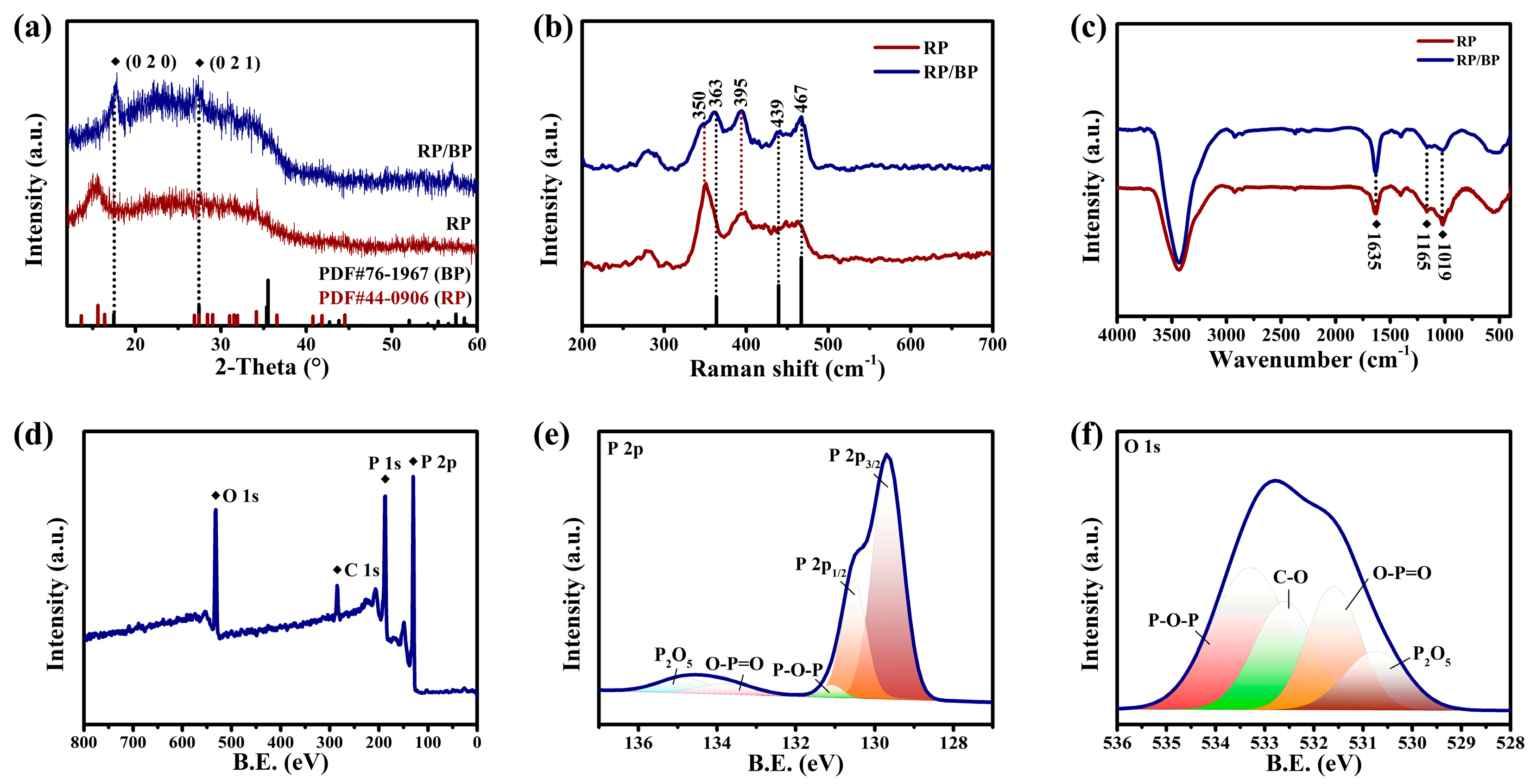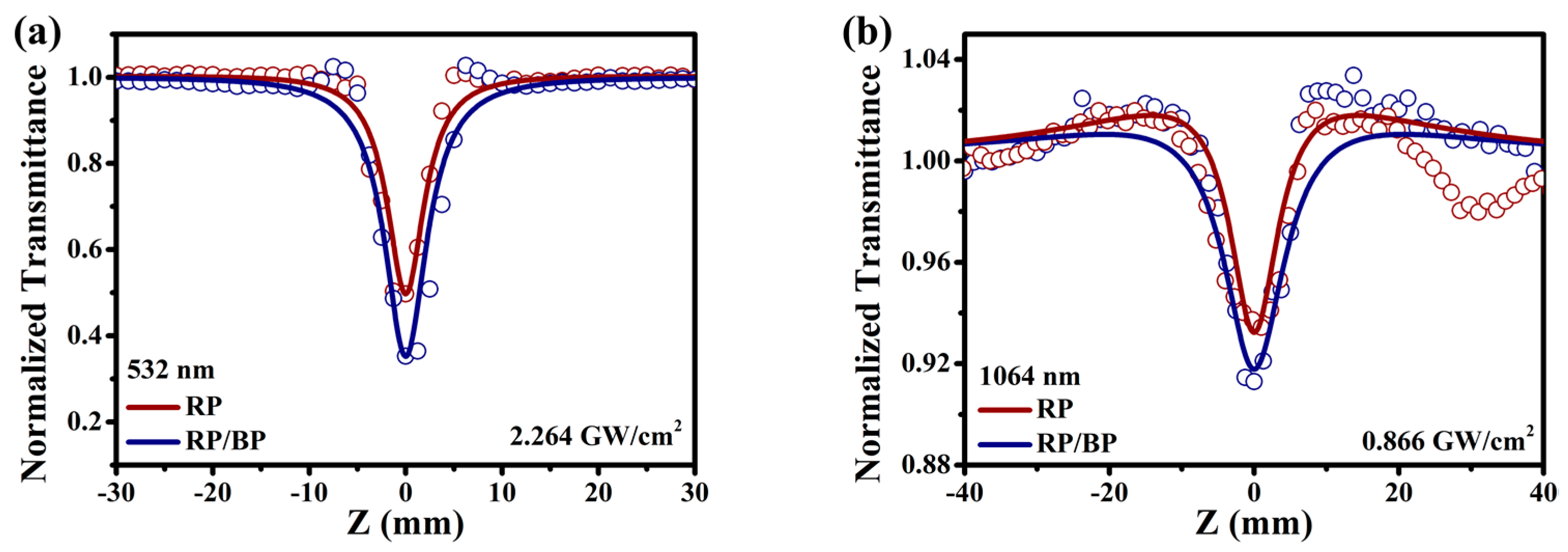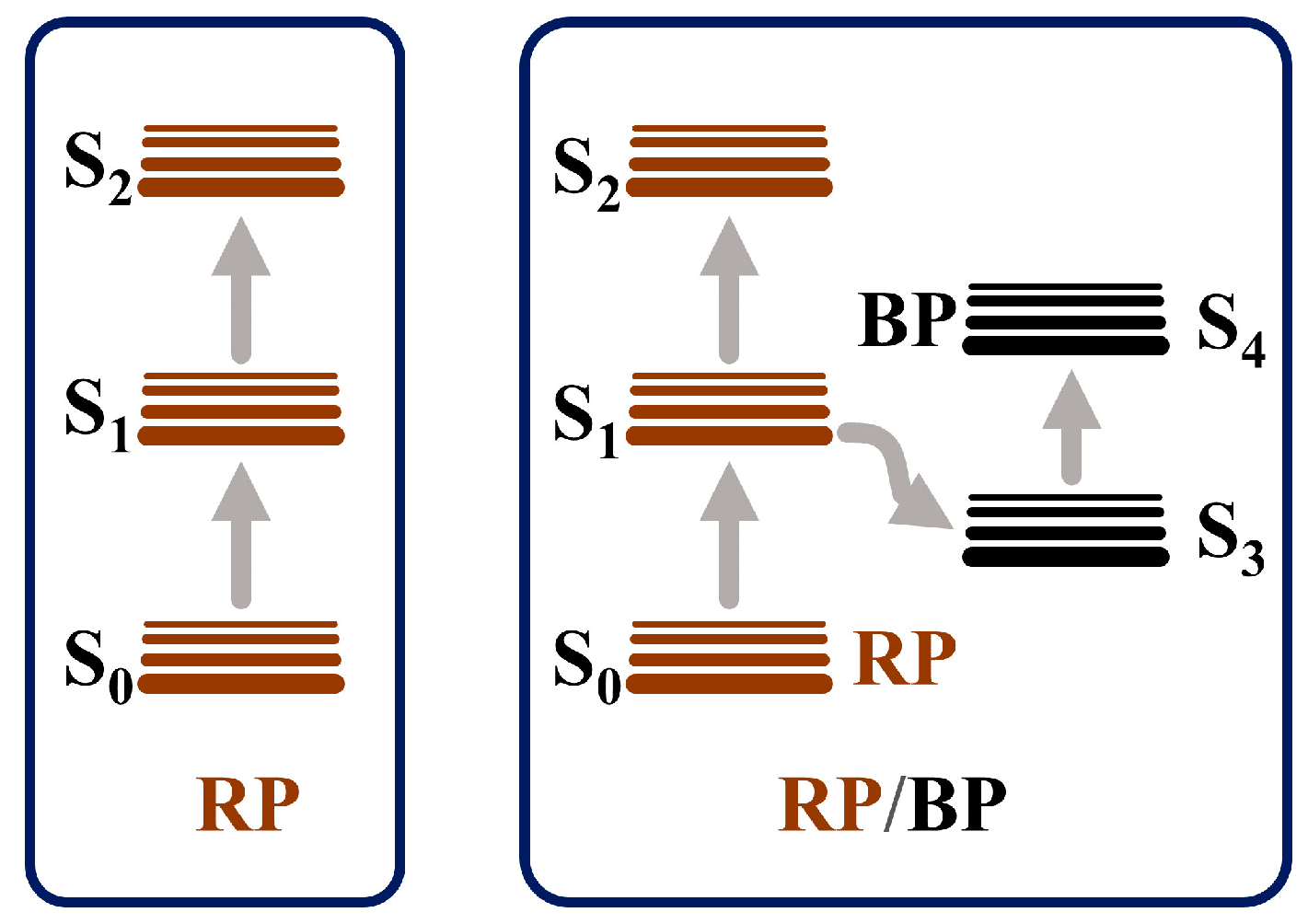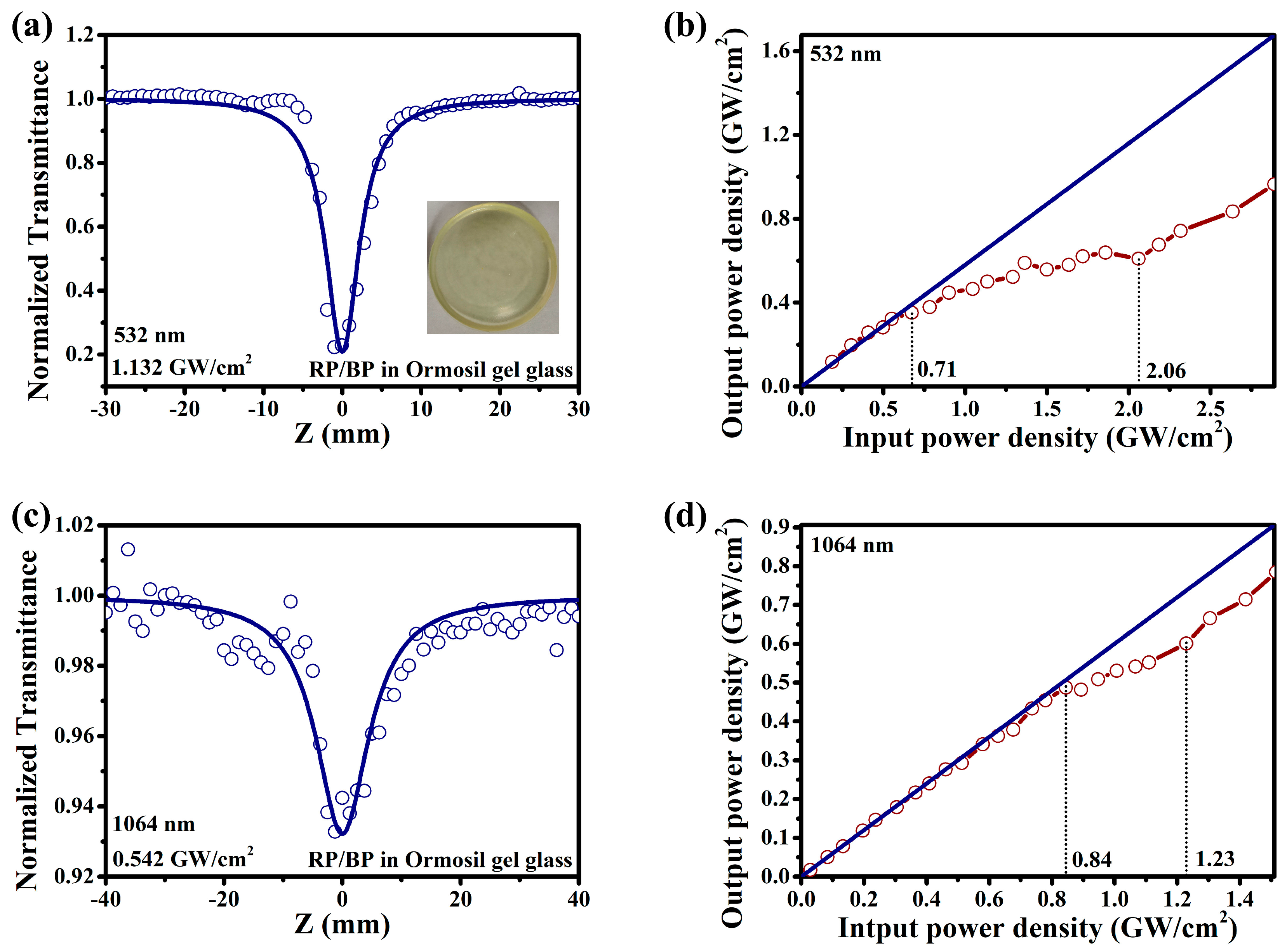Enhancement of Broadband Reverse Saturable Absorption of Red/Black Phosphorus Heterojunction
Abstract
1. Introduction
2. Results and Discussion
3. Materials and Methods
3.1. Materials
3.2. Preparation of RP/BP Heterojunction
3.3. Preparation of RP/BP Heterojunction Doped Ormosil Gel Glass
3.4. Characterization
4. Conclusions
Author Contributions
Funding
Institutional Review Board Statement
Informed Consent Statement
Data Availability Statement
Conflicts of Interest
References
- Maiman, T.H. Stimulated optical radiation in ruby. Nature 1960, 187, 493–494. [Google Scholar] [CrossRef]
- Tao, M.; Guan, J.; Peng, T.; Li, S.; Yu, S.; Song, J.; Song, Z.; Gao, L.; Gao, F. Simultaneous Realization of Laser Ranging and Communication Based on Dual-Pulse Interval Modulation. IEEE Trans. Instrum. Meas. 2021, 70, 2004610. [Google Scholar] [CrossRef]
- Audouard, E.; Mottay, E. High efficiency GHz laser processing with long bursts. Int. J. Extreme Manuf. 2023, 5, 015003. [Google Scholar] [CrossRef]
- Zhao, J.; Yan, Y.; Gao, Z.; Du, Y.; Dong, H.; Yao, J.; Zhao, Y.S. Full-color laser displays based on organic printed microlaser arrays. Nat. Commun. 2019, 10, 870. [Google Scholar] [CrossRef]
- Goldenstein, C.S.; Spearrin, R.M.; Jeffries, J.B.; Hanson, R.K. Infrared laser-absorption sensing for combustion gases. Prog. Energy Combust. Sci. 2017, 60, 132–176. [Google Scholar] [CrossRef]
- Chen, B.; Fang, D.; Chen, L.; Shen, X.; Wei, J.; Wang, D.; Zhang, Q.; Ouyang, Q.; Fang, X.; Chen, X. Adjusting the nonlinear optical and optical limiting properties of MAPbBr3/PMMA by doping with Zn. Mater. Chem. Phys. 2023, 309, 128310. [Google Scholar] [CrossRef]
- Chen, Y.; Bai, T.; Dong, N.; Fan, F.; Zhang, S.; Zhuang, X.; Sun, J.; Zhang, B.; Zhang, X.; Wang, J.; et al. Graphene and its derivatives for laser protection. Prog. Mater. Sci. 2016, 84, 118–157. [Google Scholar] [CrossRef]
- Alig, T.; Bartels, N.; Allenspacher, P.; Balasa, I.; Böntgen, T.; Ristau, D.; Jensen, L. Prevention of laser damage precursors in spaceborne ultraviolet antireflection coatings. Opt. Express 2021, 29, 14189–14200. [Google Scholar] [CrossRef]
- Deena, D.M.; Anushya, S.A.; Dhanusha, A.; Girisun, T.C.S.; Philominal, A. Peculiar nonlinear optical absorption and optical limiting behaviors of bismuth-based binary and ternary nanostructures. Diam. Relat. Mater. 2024, 141, 110656. [Google Scholar] [CrossRef]
- Wan, C.; Zhang, Z.; Salman, J.; King, J.; Xiao, Y.; Yu, Z.; Shahsafi, A.; Wambold, R.; Ramanathan, S.; Kats, M.A. Ultrathin broadband reflective optical limiter. Laser Photonics Rev. 2021, 15, 2100001. [Google Scholar] [CrossRef]
- Sun, Y.; Li, H.; Gao, X.; Humphrey, M.G.; Zhang, C.; Huang, Z. Promoting the nonlinear optical absorption of conjugated polymers by in-gap states modulation via chemical dedoping. Mater. Today Phys. 2023, 32, 101024. [Google Scholar] [CrossRef]
- Gheorghe, P.; Petris, A.; Anton, A.M. Optical limiting properties of DNA biopolymer doped with natural dyes. Polymers 2024, 16, 96. [Google Scholar] [CrossRef]
- Petris, A.; Gheorghe, P.S.; Vlad, V.I.; Rusu, E.; Ursaki, V.V.; Tiginyanu, I.M. Ultrafast third-order optical nonlinearity in SnS2 layered compound for photonic applications. Opt. Mater. 2018, 76, 69–74. [Google Scholar] [CrossRef]
- Petris, A.; Vasiliu, I.C.; Gheorghe, P.; Iordache, A.M.; Ionel, L.; Rusen, L.; Iordache, S.; Elisa, M.; Trusca, R.; Ulieru, D.; et al. Graphene oxide-based silico-phosphate composite films for optical limiting of ultrashort near-infrared laser pulses. Nanomaterials 2020, 10, 1638. [Google Scholar] [CrossRef]
- Xiang, W.; Zhu, B.; Bai, C.; Gu, B.; Lv, C.; Zhang, J. Thickness-modulated optical nonlinearity of colloidal CdSe-CdS core-shell nanoplatelets: Large two-photon absorption and self-focusing effects. Nanoscale 2023, 15, 17996–18003. [Google Scholar] [CrossRef]
- Li, L.; Shang, X.; Wang, S.; Dong, N.; Ji, C.; Chen, X.; Zhao, S.; Wang, J.; Sun, Z.; Hong, M.; et al. Bilayered hybrid perovskite ferroelectric with giant two-photon absorption. J. Am. Chem. Soc. 2018, 140, 6806–6809. [Google Scholar] [CrossRef]
- Tian, X.; Wei, R.; Guo, Q.; Zhao, Y.; Qiu, J. Reverse saturable absorption induced by phonon-assisted anti-stokes processes. Adv. Mater. 2018, 30, 1801638. [Google Scholar] [CrossRef]
- Wu, W.; Zhou, Y.; Wang, J.; Shao, Y.; Kong, D.; Gao, Y.; Wang, Y. The pump fluence and wavelength-dependent ultrafast carrier dynamics and optical nonlinear absorption in black phosphorus nanosheets. Nanophotonics 2020, 9, 2033–2043. [Google Scholar] [CrossRef]
- Acharyya, J.N.; Mishra, A.K.; Rao, D.N.; Kumar, A.; Prakash, G.V. Ultrafast nonlinear pulse propagation dynamics in metal-dielectric periodic photonic architectures. Adv. Mater. Interfaces 2021, 8, 2100757. [Google Scholar] [CrossRef]
- Tilmann, B.; Grinblat, G.; Berté, R.; Özcan, M.; Kunzelmann, V.F.; Nickel, B.; Sharp, I.D.; Cortés, E.; Maier, S.A.; Li, Y. Nanostructured amorphous gallium phosphide on silica for nonlinear and ultrafast nanophotonics. Nanoscale Horiz. 2020, 5, 1500–1508. [Google Scholar] [CrossRef]
- Lim, G.K.; Chen, Z.L.; Clark, J.; Goh, R.G.S.; Ng, W.H.; Tan, H.W.; Friend, R.H.; Ho, P.K.H.; Chua, L.L. Giant broadband nonlinear optical absorption response in dispersed graphene single sheets. Nat. Photonics 2011, 5, 554–560. [Google Scholar] [CrossRef]
- He, Y.; He, C.; Dong, B.; Fang, Y.; Zhou, K.; Deng, C.; Li, Q.; Lu, Y. Investigation on nonlinear absorption and optical limiting properties of Tm:YLF crystals. Opt. Mater. 2024, 147, 114786. [Google Scholar] [CrossRef]
- Lu, C.; Yang, D.; Ma, J.; Luo, M.; Jin, Y.; Xu, X. Effect of surface oxidation on nonlinear optical absorption in WS2 nanosheets. Appl. Surf. Sci. 2020, 532, 147409. [Google Scholar] [CrossRef]
- Liu, Y.; Li, H.; Cao, H.; Zheng, X.; Shi, B.; Yin, H. Defect and interface/surface engineering synergistically modulated electron transfer and nonlinear absorption properties in MoX2 (X = Se, S, Te)@ZnO heterojunction. Nanoscale 2024, 16, 1865–1879. [Google Scholar] [CrossRef]
- Low, J.; Yu, J.; Jaroniec, M.; Wageh, S.; Al-Ghamdi, A.A. Heterojunction photocatalysts. Adv. Mater. 2017, 29, 1601694. [Google Scholar] [CrossRef]
- Liu, F.; Shi, R.; Wang, Z.; Weng, Y.; Che, C.; Chen, Y. Direct Z-scheme hetero-phase junction of black/red phosphorus for photocatalytic water splitting. Angew. Chem. Inter. Ed. 2019, 58, 11791–11795. [Google Scholar] [CrossRef]
- Halge, D.I.; Narwade, V.N.; Kaawash, N.M.S.; Khanzode, P.M.; Shaikh, S.J.; Dadge, J.W.; Alegaonkar, P.S.; Hyam, R.S.; Bogle, K.A. High-performance blue light photodetector based on PANI/CdS heterojunction. Mater. Sci. Semicon. Proc. 2024, 171, 108020. [Google Scholar] [CrossRef]
- Trung, T.Q.; Dang, V.Q.; Lee, H.B.; Kim, D.I.; Moon, S.; Lee, N.E.; Lee, H. An omnidirectionally stretchable photodetector based on organic–inorganic heterojunctions. ACS Appl. Mater. Interfaces 2017, 9, 35958–35967. [Google Scholar] [CrossRef]
- Wang, J.; Li, Z.; Chen, H.; Deng, G.; Niu, X. Recent advances in 2D lateral heterostructures. Nano-Micro Lett. 2019, 11, 48. [Google Scholar] [CrossRef]
- Mani, K.P.; Sreekanth, P.; Vimal, G.; Biju, P.R.; Unnikrishnan, N.V.; Ittyachen, M.A.; Philip, R.; Joseph, C. Tunable emission and excited state absorption induced optical limiting in Tb2(MoO4)3: Sm3+/Eu3+ nanophosphors. Opt. Mater. 2016, 62, 110–118. [Google Scholar] [CrossRef]
- Li, Y.; Jiang, S.; Qian, Y.; Han, Y.; Zhou, J.; Li, T.; Xi, L.; Lin, N.; Qian, Y. Amine-induced phase transition from white phosphorus to red/black phosphorus for Li/K-ion storage. Chem. Commun. 2019, 55, 6751–6754. [Google Scholar] [CrossRef] [PubMed]
- Luo, Z.; Zhang, Y.; Zhang, C.; Tan, H.; Li, Z.; Abutaha, A.; Wu, X.; Xiong, Q.; Khor, K.A.; Hippalgaonkar, K.; et al. Multifunctional 0D-2D Ni2P nanocrystals-black phosphorus heterostructure. Adv. Energy Mater. 2017, 7, 1601285. [Google Scholar] [CrossRef]
- Rissi, E.N.; Soignard, E.; McKiernan, K.A.; Benmore, C.J.; Yarger, J.L. Pressure-induced crystallization of amorphous red phosphorus. Solid State Commun. 2012, 152, 390–394. [Google Scholar] [CrossRef]
- Lu, W.; Nan, H.; Hong, J.; Chen, Y.; Zhu, C.; Liang, Z.; Ma, X.; Ni, Z.; Jin, C.; Zhang, Z. Plasma-assisted fabrication of monolayer phosphorene and its Raman characterization. Nano Res. 2014, 7, 853–859. [Google Scholar] [CrossRef]
- Hu, Z.; Yuan, L.; Liu, Z.; Shen, Z.; Yu, J.C. An elemental phosphorus photocatalyst with a record high hydrogen evolution efficiency. Angew. Chem. Inter. Ed. 2016, 55, 9580–9585. [Google Scholar] [CrossRef]
- Gnanasekaran, L.; Pachaiappan, R.; Kumar, P.S.; Hoang, T.K.A.; Rajendran, S.; Durgalakshmi, D.; Soto-Moscoso, M.; Cornejo-Ponce, L.; Gracia, F. Visible light driven exotic p (CuO)-n (TiO2) heterojunction for the photodegradation of 4-chlorophenol and antibacterial activity. Environ. Pollut. 2021, 287, 117304. [Google Scholar] [CrossRef]
- Tauc, J.; Grigorovici, R.; Vancu, A. Optical properties and electronic structure of amorphous Germanium. Phys. Status Solidi B 1966, 15, 627–637. [Google Scholar] [CrossRef]









Disclaimer/Publisher’s Note: The statements, opinions and data contained in all publications are solely those of the individual author(s) and contributor(s) and not of MDPI and/or the editor(s). MDPI and/or the editor(s) disclaim responsibility for any injury to people or property resulting from any ideas, methods, instructions or products referred to in the content. |
© 2024 by the authors. Licensee MDPI, Basel, Switzerland. This article is an open access article distributed under the terms and conditions of the Creative Commons Attribution (CC BY) license (https://creativecommons.org/licenses/by/4.0/).
Share and Cite
Wang, J.; Liu, F.; Li, Y.; Chen, L.; Chen, Y.; Zhang, H.; Xie, Z. Enhancement of Broadband Reverse Saturable Absorption of Red/Black Phosphorus Heterojunction. Molecules 2024, 29, 1271. https://doi.org/10.3390/molecules29061271
Wang J, Liu F, Li Y, Chen L, Chen Y, Zhang H, Xie Z. Enhancement of Broadband Reverse Saturable Absorption of Red/Black Phosphorus Heterojunction. Molecules. 2024; 29(6):1271. https://doi.org/10.3390/molecules29061271
Chicago/Turabian StyleWang, Jingjing, Fulai Liu, Yunfei Li, Long Chen, Yong Chen, Hailong Zhang, and Zheng Xie. 2024. "Enhancement of Broadband Reverse Saturable Absorption of Red/Black Phosphorus Heterojunction" Molecules 29, no. 6: 1271. https://doi.org/10.3390/molecules29061271
APA StyleWang, J., Liu, F., Li, Y., Chen, L., Chen, Y., Zhang, H., & Xie, Z. (2024). Enhancement of Broadband Reverse Saturable Absorption of Red/Black Phosphorus Heterojunction. Molecules, 29(6), 1271. https://doi.org/10.3390/molecules29061271







